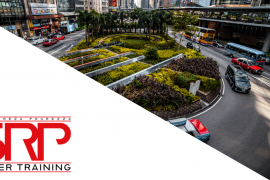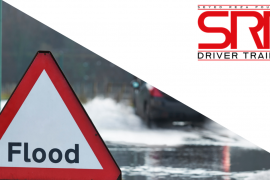Road signs in the UK have been around since the 1800s but with the advent of the motor car the need for clear and concise signage became much greater. Several attempts to rework the old road signs littered the early 20th century until 1957 when the current road signage system was born.
The current system was the product of two committees, the 1957 Anderson Committee and the Worboys Committee of 1963. First, the Anderson Committee developed a comprehensive range of road signs, specifically optimised for the new motorway network. The committee developed new font faces for the signs, known as Transport and Transport Heavy, the latter specifically designed to be easier to read at the new motorway speed limits.
The Worboys Committee later reviewed the signage and introduced the Traffic Signs Regulations and General Directions (TSRGD), a Statutory Instrument that governs how and where signs are placed on the roads.
Finally, a new system of colour coding was introduced in the 1980s which simplified the signage on larger road signs and gives us the system which is in use today.
As a learner driver, you don’t need to know all about the history of road signs, but the review carried out by Colin Anderson, T.G. Usborne, Jock Kinneir and Margaret Calvert did introduce a logical system which allows you as a novice road user to decode the road signs you don’t know.
Shaping The Road Network – Shape Gives Road Signs Purpose



The first thing to look at when you are trying to figure out a road sign you’ve never seen before is the shape. There are three main shapes to all UK road signs. These give you the purpose of the sign without needing to see anything else.
Circular road signs give you orders. The easy way to remember this is that O is an Order.
Think of the round road signs you see on the road, speed limits, no entry signs, weight and height restrictions. All of these signs are non-discretionary. You cannot continue if you don’t satisfy the requirements of the sign.
There are also permissive orders; like signs telling you where to go, signs allowing certain types of vehicles to use certain parts of the road and signs which tell you the minimum speed limit in force. Then there is the mini-roundabout sign which orders you to treat the next bit of road as a roundabout.
Triangular road signs give you warnings. The most common triangular road sign we see is Give Way, with a unique shape we will cover later. Others include pre-warning drivers of large vehicles of height or width restrictions and warnings about schools or playgrounds.
Warning signs are often included in larger information signs. Their triangular shape ties into other warning signs we see in the world. Chemical warning signs on bottles are often triangular, as are signs alerting you to high-voltage electrical equipment and even fragile packages.
Finally, we have rectangular road signs. These are for information and often give either additional detail to the Orders or Warnings which share their signpost. They can also give direction information. Other information signs give details of time restrictions and are to be read in conjunction with road markings or other signs which are in different locations.
The Roads Signs Exceptions That Prove the Rules.
There are two road signs which are uniquely shaped. The first is the Give Way sign, which we’ve briefly discussed above. The Give Way sign is the only triangular warning sign where the point of the triangle faces downwards. This serves two purposes:
- The sign’s shape is unique, just the outline of the sign tells you what it wants you to do. The sun, snow and even dirt can obscure the sign but the shape tells you what they mean.
- Whereas most warning signs are a point-up triangle, the Give Way sign is a point-down one. The secondary consideration for your average warning sign is that the shape not only tells you it’s giving you a warning, it also points to the direction of the hazard it’s warning you about. A Give Way sign doesn’t, instead when you read the sign from bottom to top, (as you should all road signs) the sign widens out into a bar blocking your path. It’s a subtle psychological trick which encourages you to slow down and be more careful.
The other uniquely shaped road sign is the STOP sign. This is the only octagonal road sign in the TSRGD. The reasons are the same as for the Give Way sign. It’s so you can tell what the sign is saying, even when you can’t actually read it.
Colouring In – The Colours Tell The Story
Almost all the order and warning signs in the UK follow the same two colour rules.
- Red White and Black – Hold Back. Signs with white backgrounds, red borders and black text or pictograms are either warning you about a hazard ahead or telling you not to do what is depicted. Look at a speed limit sign where O is an Order, Red, White and Black hold back from 30. Don’t go over 30 miles per hour.
- Blue, You Do. Blue and white road signs which are round are signs which tell you what you must do. We discussed the mini roundabout sign above. O is an Order, Blue you must do, treat the next bit of road like a roundabout. You also see blue and white road signs in bus lanes and other restricted access areas. These information signs tell you which types of vehicles can use the roads, and also which times the restrictions are in place.
There are other colours in the UK’s collection of road signs. Once you get to rectangular signs the two rules above go out of the window.
Blue rectangular road signs are for the motorway network. They will either point the way towards the motorway or are used to give information to vehicles already on it. Blue and white information signs will also use the Transport Heavy font to identify the motorway they are directing you towards.
Green rectangles give information on other major routes. This is mainly the A Road network which forms the rest of the strategic road network and is often used when the motorways are either closed or very busy. These green road signs are also often joined by gold numbering for the truly major A Roads in the area. The gold lettering is to point out the strategic road network which isn’t a motorway.
White rectangular road signs give information on local routes. They may also give additional information relating to orders or warnings depicted by other road signs.
Temporary and Tourist Road Signs
Brown rectangles are for tourist attractions and Yellow road signs are for temporary signage. You will most regularly see yellow signs for road work. You can also find them at major events which use temporary signs for directing traffic. Sheffield-based learner drivers may be familiar with these signs. Tramlines festival has a lot of these signs for visitors, as does the Snooker Championships which are played at the Crucible.

White road signs with a red border are used to point in the direction of MoD bases. Black information signs with white text and pictograms are used to provide information specifically to HGV drivers.
The Odd One Out
The only road sign which doesn’t conform to the colour rules above is the national speed limit sign. This sign is a white circle with a black line diagonally through it.
The reason for this isn’t 100% certain but it’s thought to be because it’s an end to a previously signed restriction and falls back on the law of the land which tells us that the national speed limit is 60 miles an hour, or 70 on a dual carriageway and 30 miles per hour where street lights are present.
Variable signs also don’t always follow the colour rules, due to the colouring of the hardware itself. Speed limit signs on smart motorways for example are still red, white and black, but instead of being black text on a white background, the LED lights which make up the sign show a red circle and white text on the matrix sign’s black background.
The No Waiting (unless loading or unloading) sign and the No Stopping sign also differ slightly. They are red circles with either a red diagonal line or a red cross on a blue background.

Content – Say What You See
The final key to deciphering a road sign you’ve never seen before is the image contained within. Sometimes it’s harder to decode than others. The No Overtaking sign for example which people often joke is that red cars can pass black ones.
Usually, the image is fairly clear. Roadworks are depicted by a man shovelling from a pile of dirt. Traffic lights are shown on the warning sign.
Take a look at the signs shown below and try to decode their purpose. At the bottom of the article, you will find the answers to each sign and what it means.






So, now you know how to decode a road sign, even if you’ve never seen the sign before. This is very useful for your theory test but even more important out on the road. Remember; Shape, Colour, Content. The key to understanding road signs.
Answers: Left to right.
No Horses | Mini Roundabout | End of Minimum Speed Limit
Speed Camera Ahead | No Motor Vehicles | Mandatory Left Turn




